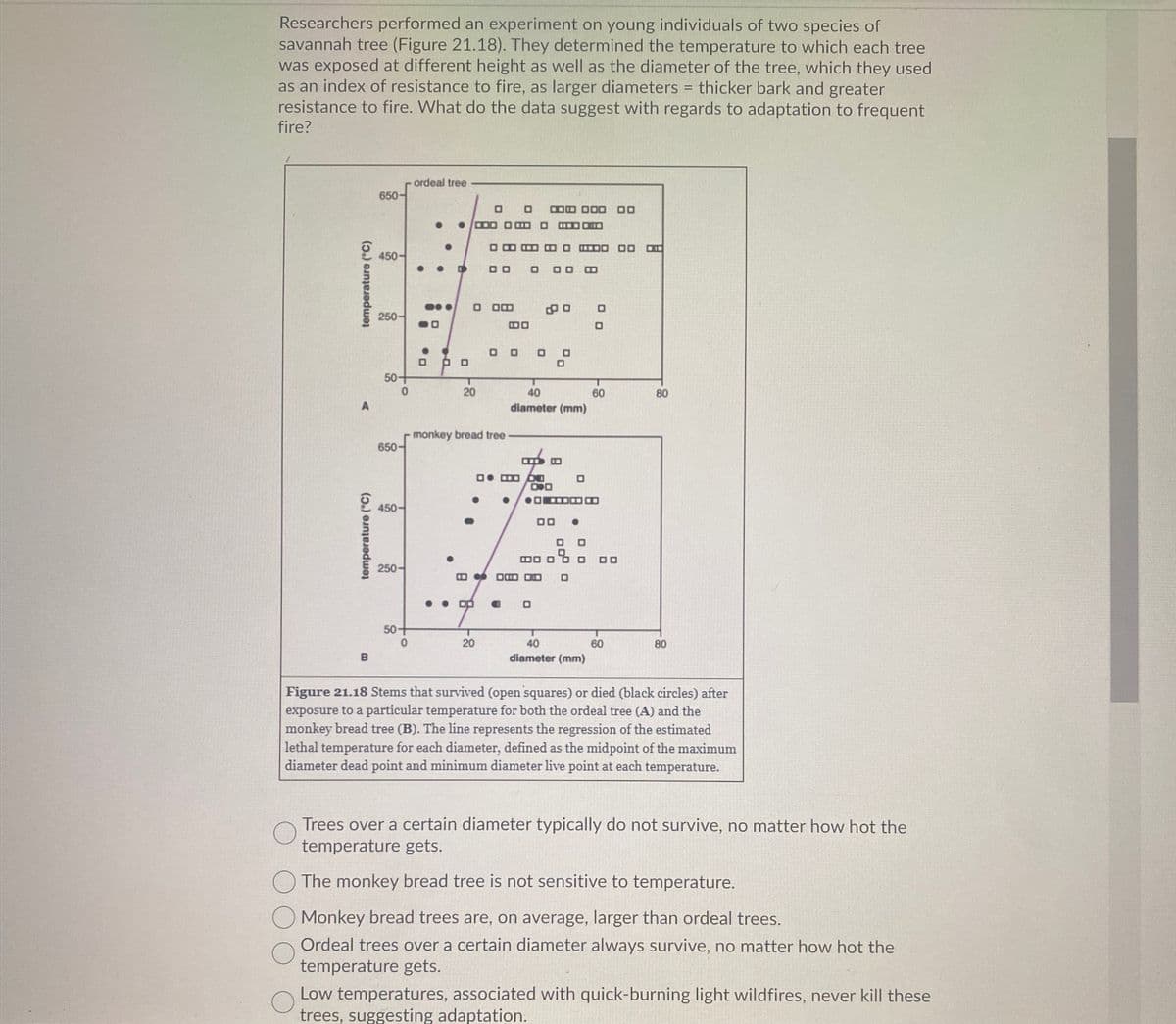Researchers performed an experiment on young individuals of two species of savannah tree (Figure 21.18). They determined the temperature to which each tree was exposed at different height as well as the diameter of the tree, which they used as an index of resistance to fire, as larger diameters = thicker bark and greater resistance to fire. What do the data suggest with regards to adaptation to frequent fire? ordeal tree 650- • 0 D m O DOD 9 450- O Om DO DO 0O .. 0O O 00 O . O D0 250- 50- 20 40 diameter (mm) 60 80 rmonkey bread tree 650- 2 450- Do ob o 250- O DD OD • op 50- 20 40 60 80 B diameter (mm) Figure 21.18 Stems that survived (open squares) or died (black circles) after exposure to a particular temperature for both the ordeal tree (A) and the monkey bread tree (B). The line represents the regression of the estimated lethal temperature for each diameter, defined as the midpoint of the maximum diameter dead point and minimum diameter live point at each temperature. Trees over a certain diameter typically do not survive, no matter how hot the temperature gets. The monkey bread tree is not sensitive to temperature. Monkey bread trees are, on average, larger than ordeal trees. Ordeal trees over a certain diameter always survive, no matter how hot the temperature gets. Low temperatures, associated with quick-burning light wildfires, never kill these trees, suggesting adantation temperature ("C)
Researchers performed an experiment on young individuals of two species of savannah tree (Figure 21.18). They determined the temperature to which each tree was exposed at different height as well as the diameter of the tree, which they used as an index of resistance to fire, as larger diameters = thicker bark and greater resistance to fire. What do the data suggest with regards to adaptation to frequent fire? ordeal tree 650- • 0 D m O DOD 9 450- O Om DO DO 0O .. 0O O 00 O . O D0 250- 50- 20 40 diameter (mm) 60 80 rmonkey bread tree 650- 2 450- Do ob o 250- O DD OD • op 50- 20 40 60 80 B diameter (mm) Figure 21.18 Stems that survived (open squares) or died (black circles) after exposure to a particular temperature for both the ordeal tree (A) and the monkey bread tree (B). The line represents the regression of the estimated lethal temperature for each diameter, defined as the midpoint of the maximum diameter dead point and minimum diameter live point at each temperature. Trees over a certain diameter typically do not survive, no matter how hot the temperature gets. The monkey bread tree is not sensitive to temperature. Monkey bread trees are, on average, larger than ordeal trees. Ordeal trees over a certain diameter always survive, no matter how hot the temperature gets. Low temperatures, associated with quick-burning light wildfires, never kill these trees, suggesting adantation temperature ("C)
Biology: The Dynamic Science (MindTap Course List)
4th Edition
ISBN:9781305389892
Author:Peter J. Russell, Paul E. Hertz, Beverly McMillan
Publisher:Peter J. Russell, Paul E. Hertz, Beverly McMillan
Chapter53: Population Interactions And Community Ecology
Section: Chapter Questions
Problem 1ITD
Related questions
Question

Transcribed Image Text:Researchers performed an experiment on young individuals of two species of
savannah tree (Figure 21.18). They determined the temperature to which each tree
was exposed at different height as well as the diameter of the tree, which they used
as an index of resistance to fire, as larger diameters = thicker bark and greater
resistance to fire. What do the data suggest with regards to adaptation to frequent
fire?
ordeal tree
650-
O O
8EDOD
COO O D
450-
O OO 0
250
O O
50+
20
40
60
80
diameter (mm)
monkey bread tree
650-
BI
450-
O O
250-
50+
20
40
60
80
diameter (mm)
Figure 21.18 Stems that survived (open squares) or died (black circles) after
exposure to a particular temperature for both the ordeal tree (A) and the
monkey bread tree (B). The line represents the regression of the estimated
lethal temperature for each diameter, defined as the midpoint of the maximum
diameter dead point and minimum diameter live point at each temperature.
Trees over a certain diameter typically do not survive, no matter how hot the
temperature gets.
O The monkey bread tree is not sensitive to temperature.
Monkey bread trees are, on average, larger than ordeal trees.
Ordeal trees over a certain diameter always survive, no matter how hot the
temperature gets.
Low temperatures, associated with quick-burning light wildfires, never kill these
trees, suggesting adaptation.
temperature ("C)
temperature ("C)
Expert Solution
This question has been solved!
Explore an expertly crafted, step-by-step solution for a thorough understanding of key concepts.
This is a popular solution!
Trending now
This is a popular solution!
Step by step
Solved in 3 steps

Knowledge Booster
Learn more about
Need a deep-dive on the concept behind this application? Look no further. Learn more about this topic, biology and related others by exploring similar questions and additional content below.Recommended textbooks for you

Biology: The Dynamic Science (MindTap Course List)
Biology
ISBN:
9781305389892
Author:
Peter J. Russell, Paul E. Hertz, Beverly McMillan
Publisher:
Cengage Learning

Biology: The Unity and Diversity of Life (MindTap…
Biology
ISBN:
9781305073951
Author:
Cecie Starr, Ralph Taggart, Christine Evers, Lisa Starr
Publisher:
Cengage Learning


Biology: The Dynamic Science (MindTap Course List)
Biology
ISBN:
9781305389892
Author:
Peter J. Russell, Paul E. Hertz, Beverly McMillan
Publisher:
Cengage Learning

Biology: The Unity and Diversity of Life (MindTap…
Biology
ISBN:
9781305073951
Author:
Cecie Starr, Ralph Taggart, Christine Evers, Lisa Starr
Publisher:
Cengage Learning


Biology: The Unity and Diversity of Life (MindTap…
Biology
ISBN:
9781337408332
Author:
Cecie Starr, Ralph Taggart, Christine Evers, Lisa Starr
Publisher:
Cengage Learning